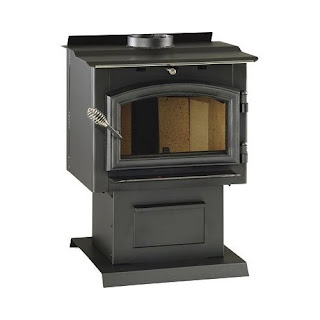
A wood-burning stove is a heating appliance capable of burning wood-fuel and wood-derived biomas fuel.
Generally the appliance consists of a solid metal closed fire chamber, a grate and an adjustable air control. The appliance will be connected to a suitable chimney or flue which will fill with hot combustion gases once the fuel is ignited. It is critical that the chimney or flue gases be hotter than the outside temperature as this will result in combustion gases being drawn out of the fire chamber and up the chimney.
Clearly there are different types of wood, but they will usually fall into either the hardwood or softwood types. Both types of wood have the same energy content (by mass) and will provide similar energy outputs. However, the essential difference will be in the rate at which the fuel burns.
Hardwoods derived from slow-growing broadleaf trees will burn at a slower rate for sustained output. Softwoods are derived from evergreen trees such as conifers, which are fast growing but burn at a far greater rate.
One of the most critical factors in wood burning is the moisture content of the wood, as any water in firewood has to be boiled off during the burning process. But the moisture content can be reduced by seasoning. Freshly cut wood will contain a moisture content of around 65-90%.
This wood should never be used for firewood. Apart from producing very low heat outputs this wet wood will also generate large amounts of soot and tar, which can potentially lead to chimney fires (as these particles will coat your chimney and will fuel a chimney fire). For best results firewood should have a moisture content of less than 20%.
The process of removing the excess moisture is called seasoning. Seasoning by air drying the wood can take up to two years. Wood should be stored in a well ventilated (but covered) structure, outdoors. A recent innovation is kiln dried wood. With interest and usage of wood burners at an all time high, some companies are now using large kilns to quickly dry their wood.
High heating efficiencies on closed appliances can only be attained by controlling the supply of air to the fire chamber (operating the air control correctly). It is not recommended to leave the air control fully open, beyond the point of getting the chimney/flue hot initially.
A fully open air control will lead to more heat being sent straight up the chimney rather than into the room (reduced efficiency). The biggest problem with leaving the air control fully open is “overfiring”. Overfiring is caused when too much heat is generated within the fire chamber, which will lead to warping, buckling and general damage to the stove and its internal components. Individual stoves will have their own quirks, so take a little time to get used to your settings.
 Click here to purchase your Wood Burning Stove today
Click here to purchase your Wood Burning Stove today






No comments:
Post a Comment